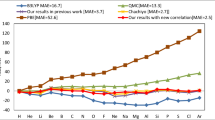Play all audios:

ABSTRACT A NUCLEAR quadrupole resonance signal1 is split into two components by electrostatic fields2 with up to maximum field strengths of 50 kV/cm. The separation between the two
components is a linear function2 of the polarizability of the molecular species under investigation. The aim of this communication is to demonstrate the general validity of this particular
relationship2 which is in fact independent of any restricting experimental conditions, for example application of an electrostatic field (Stark effect2). Although there are relatively few
compounds for which both the nuclear quadrupole resonance and molecular polarizability data are available, the general validity of the correlation between the molecular polarizability and
nuclear quadrupole resonance parameters, such as the molecular electric field gradients _q_zz, can be demonstrated conclusively in the series of the homologous compounds CH3C1, CH2Cl2 and
CHCl3. The relevant experimental data3–7 are shown in Table 1 and illustrated in Fig. 1. Access through your institution Buy or subscribe This is a preview of subscription content, access
via your institution ACCESS OPTIONS Access through your institution Subscribe to this journal Receive 51 print issues and online access $199.00 per year only $3.90 per issue Learn more Buy
this article * Purchase on SpringerLink * Instant access to full article PDF Buy now Prices may be subject to local taxes which are calculated during checkout ADDITIONAL ACCESS OPTIONS: *
Log in * Learn about institutional subscriptions * Read our FAQs * Contact customer support SIMILAR CONTENT BEING VIEWED BY OTHERS INTRODUCING A NEW CORRELATION FUNCTIONAL IN DENSITY
FUNCTIONAL THEORY Article Open access 31 July 2024 ZERO-FIELD _J_-SPECTROSCOPY OF QUADRUPOLAR NUCLEI Article Open access 27 May 2024 RELATIVE CONFIGURATION OF MICROGRAMS OF NATURAL COMPOUNDS
USING PROTON RESIDUAL CHEMICAL SHIFT ANISOTROPY Article Open access 01 September 2020 REFERENCES * Dehmelt, H. G., and Krüger, H., _Naturwissenschaften._, 37, 111 (1950). Article CAS ADS
Google Scholar * Duchesne, J., Read, M., and Cornil, P., _J. Phys. Chem. Solids_, 24, 1338 (1963). Article Google Scholar * Livingston, R., _J. Phys. Chem._, 57, 496 (1953). Article
CAS Google Scholar * Gutowsky, H., and McCall, D., _J. Chem. Phys._, 32, 549 (1960). Article ADS Google Scholar * Pound, R., and Watkins, G., _Prog. Nucl. Phys._, 2, 21 (1952). Google
Scholar * Livingston, R., _Phys. Rev._, 82, 289 (1951). Article CAS ADS MathSciNet Google Scholar * Stuart, H. A., in _Die Struktur des Freien Moleküls_, 440 (Springer-Verlag, 1952).
Book Google Scholar * Landolt-Börnstein, in _Zahlenwerte und Funktionen_, 1, Part 3, 515 (Springer-Verlag, 1951). MATH Google Scholar * _Gmelin's Handbuch der Anorganischen Chemie,
Silicium_, eighth ed. * Landolt-Börnstein, _Zahlenwerte und Funktionen_, 1, Part 2 260 121, 267 (Springer-Verlag, 1951). MATH Google Scholar * Clausius, R., _Mechanische Wärmetheorie_, 2,
94 (1874). Google Scholar * Mosotti, O. F., _Mem. Math. Fis. Modena_, 24, Part II, 49 (1850). Google Scholar * Townes, C. H., and Dailey, B. P., _J. Chem. Phys._, 17, 783 (1949). Article
ADS Google Scholar * Das, T. P., and Hahn, E. L., _Solid State Phys._, suppl. 1, 101 (1958). * Hückel, W., in _Structural Chemistry of Inorganic Compounds_, 471 (Elsevier, 1951). Google
Scholar * Gerdil, R., _Nature_, 212, 922 (1966). Article CAS ADS Google Scholar * Lucken, E. A. C., and Whitehead, M. A., _J. Chem. Soc._, 2459 (1961). * Iredale, T., _Nature_, 177, 36
(1956). Article CAS ADS Google Scholar * Meal, H. C., _J. Amer. Chem. Soc._, 74, 6121 (1952). Article CAS Google Scholar * Bray, P. J., and Barnes, R. G., _J. Chem. Phys._, 22, 1787
(1954); ibid., 27, 551 (1957). Article CAS ADS Google Scholar * Das, T. P., and Hahn, E. L., _Solid State Phys._, suppl. 1, 18 (1958). Download references AUTHOR INFORMATION Author notes
* PAUL MACHMER Present address: Department of Chemistry, University of Leicester, AUTHORS AND AFFILIATIONS * Institute of Inorganic Chemistry, University of Cologne, Germany PAUL MACHMER
Authors * PAUL MACHMER View author publications You can also search for this author inPubMed Google Scholar RIGHTS AND PERMISSIONS Reprints and permissions ABOUT THIS ARTICLE CITE THIS
ARTICLE MACHMER, P. Empirical Correlation between the Molecular Electric Field Gradients and the Average Molecular Polarizabilities of some Halogen Compounds. _Nature_ 217, 165–166 (1968).
https://doi.org/10.1038/217165a0 Download citation * Received: 14 December 1967 * Published: 01 January 1968 * Issue Date: 13 January 1968 * DOI: https://doi.org/10.1038/217165a0 SHARE THIS
ARTICLE Anyone you share the following link with will be able to read this content: Get shareable link Sorry, a shareable link is not currently available for this article. Copy to clipboard
Provided by the Springer Nature SharedIt content-sharing initiative
